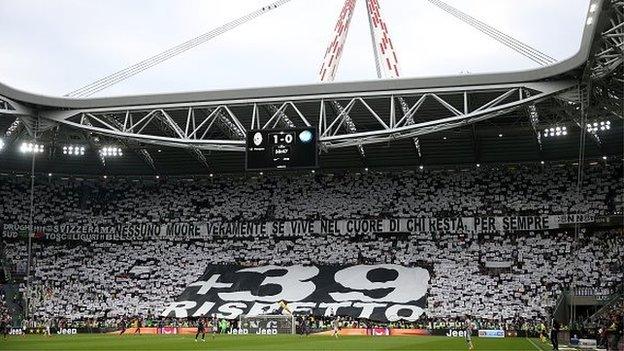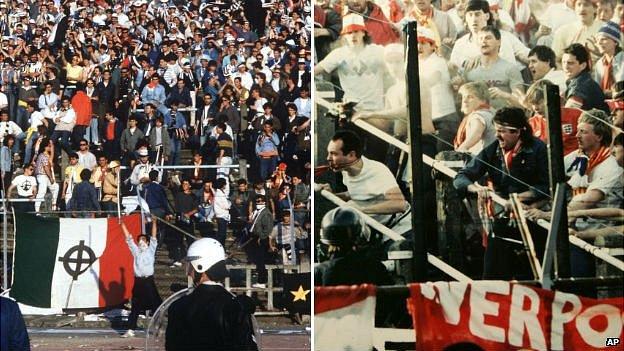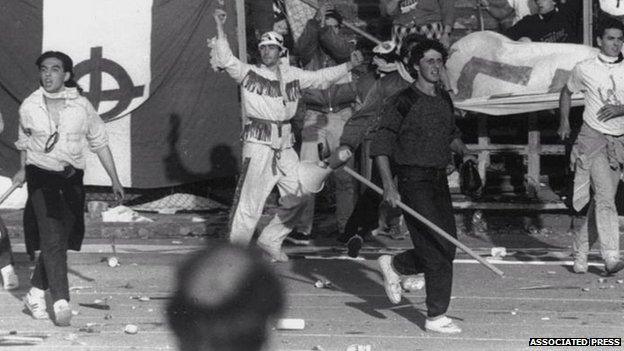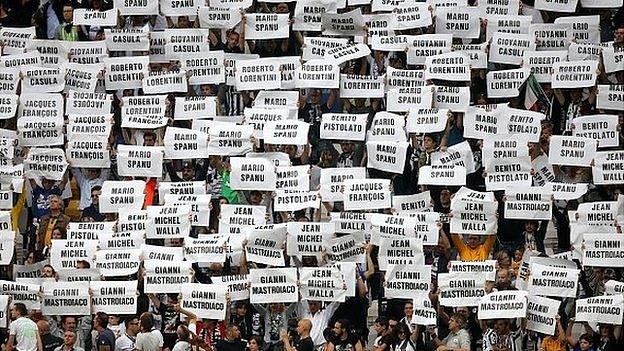Heysel disaster: English football's forgotten tragedy?
- Published

Juventus fans remembered the victims of the Heysel disaster at a recent match but there have been few commemorations in England
The 1980s were dark days for football, with the horrors of Hillsborough and Bradford etched into memories forever. But has the Heysel disaster 30 years ago become the game's forgotten tragedy?
For generations of modern football fans weaned on all-seater stadia and polished television coverage, it must be hard to imagine that a day at the match could become a matter of life and death.
The fire that ripped through a rickety wooden stand at Bradford, claiming 56 lives, and the terrible events at Hillsborough left a murky stain on the game and those who governed it, leading to many changes.
Yet for some, the catastrophe at Heysel Stadium in Brussels, Belgium, on 29 May 1985 sits somewhat uneasily in this series of disasters.
Thirty-nine people died and 600 were injured when fans were crushed against a wall that then collapsed during the European Cup final between Liverpool and Juventus, after crowd trouble culminated in a surge by Liverpool supporters towards the Italian team's fans.
It resulted in all English clubs being banned from Europe for five years and exacerbated English supporters' increasingly thuggish reputation at the time.

Some Juventus fans made their feelings clear during a match against Liverpool in Turin 10 years ago
Guilt and blame festered between the two sets of supporters for years, and emotions were still palpable in 2005 when the two clubs met for the first time since the disaster in a Champions League quarter-final at Anfield.
Liverpool fans held coloured cards spelling the word "Amicizia" (Friendship), and while the gesture was applauded by many Juventus supporters, others made a very public point of turning their backs.
Dr Rogan Taylor, a lecturer in football studies at the University of Liverpool, said a complex set of feelings surrounded the disaster because people were ashamed to face up to the uncomfortable reality of hooliganism.
The Liverpool supporter said Heysel was "a black day" for the city.
"The feeling in the city was one of desperate, desperate shame and depression," he said.
"We had a controversial local government at the time and everything was going to hell in a handcart. There were only two great cultural sources of excellence - music and football.
"We had the best football team in the world and this was a stab in the heart for the city. It was a black, black day."

What happened in the Heysel disaster?

The disaster happened after crowd disorder between Liverpool and Juventus fans at the 1985 European Cup final
About an hour before kick off at the 1985 European Cup final, a group of Liverpool fans crossed a fence separating them from a neutral area containing mostly Juventus fans.
As they fled the threat, the fans were crushed together in a section of terrace hemmed in by a concrete retaining wall, which eventually collapsed. Thirty-nine people died. The game was played despite the disaster in order to prevent further disorder, with Juventus winning 1-0.
Among those killed were 32 Italians, four Belgians, two French fans and one from Northern Ireland. It resulted in all English football clubs being banned from playing in Europe for five years. Fourteen Liverpool fans were found guilty of manslaughter and each jailed for three years.

Dr Taylor said that because the disaster happened in Belgium, it was not something English supporters - and the authorities - could analyse and come to terms with in the way they might have done had it happened in the UK.
"It was a tragedy that happened in a foreign land."
Four years later, 96 Liverpool fans lost their lives after a fatal crush during the 1989 FA Cup semi-final between Liverpool and Nottingham Forest at Sheffield Wednesday's Hillsborough stadium.
The circumstances of exactly what happened that day have been pored over for 26 years now, largely thanks to a campaign for truth waged by the bereaved families of the victims.
New inquests into the disaster are probing allegations of a complex series of failures by the authorities on the day.

Juventus fans pictured during the disorder ahead of the match at Heysel stadium
The blame for Heysel was initially laid entirely on Liverpool fans, and 14 were later found guilty of manslaughter and jailed.
However, an investigation did concede that some culpability lay with the authorities, and the crumbling state of the Heysel stadium.
Phil Hammond, who lost his 14 year-old son, Philip, at Hillsborough, said he remembers Heysel well.
"I think when Hillsborough happened, they just thought it was another Heysel," he said. "I do think if Heysel hadn't happened, things would have been very different, because people just automatically thought 'hooliganism'.
"But as we are seeing now, we are finally getting to the truth [at the new Hillsborough inquests].
"I remember Heysel well because one of my friends had a ticket. He was pulling injured people out.
"People just didn't want to talk about it and put it to the back of their minds. They were ashamed.
"I think it has been forgotten. There's only a little plaque at Anfield. But the club cannot forget it."
The Hillsborough disaster is marked with large memorials at both Hillsborough and Anfield stadiums and in the form of the Hillsborough eternal flame on Liverpool's club crest.
Reference to Heysel is, however, harder to find. There is a small memorial plaque dedicated to the victims inside Liverpool's club museum, with the shirt worn by Kenny Dalglish on the night draped alongside.

Liverpool fans held placards spelling the word "friendship" in Italian during a match with Juventus in 2005

Juventus fans held posters with the names of the victims of the disaster during a clash with Napoli
For some Juventus fans, there is a perception that many people in England have indeed forgotten the Heysel disaster - although the reasons for this remain complex.
The bianconeri have made several poignant gestures this year, including a huge display of placards bearing the names of the victims during a recent Serie A match against Napoli.
But there has been little, if any, mention of Heysel during England's most recent football season, other than a small private wreath-laying service planned at Anfield later.
Lifelong Juventus supporter Gurjit Kahlon, from Coventry, said: "I think it has been forgotten. It's not something that's spoken about here, and may well be discussed more frequently in Turin.
"I think with Hillsborough and Bradford there has been a sense of unfinished business and justice that needs to be addressed.
"And those disasters played out closer to home at domestic clubs, so they're more likely to be talked about.
"But for Juventus fans, feelings run pretty deep and it's split down the middle between those who are happy to move on and those who are still angry, as you saw at the 2005 game at Anfield.
"It would certainly be nice to have some sort of commemorative gesture here. Something to initiate a conversation and to just talk about Heysel again."
Correction 2 August 2016: This story has been amended following a complaint that was upheld by the BBC's Editorial Complaints Unit.